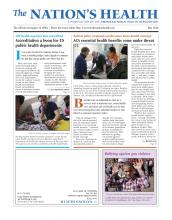Gay and bisexual boys in high school receive less HIV education than their peers although they are at a higher risk of HIV infection, a new study finds.
The study, published in the March issue of LGBT Health, used data from the Youth Risk Behavior Surveillance System, which showed that about 84 percent of gay and bisexual high school-age boys had received school-based HIV education, compared with about 90 percent of high school-age boys who only had sex with girls. Gay and bisexual boys were also more likely than their peers who had sex only with girls to report having at least four sexual partners in their lifetime, having at least three sexual partners within the past three months and using condoms at lower rates.
School-based HIV education was linked to reductions in sexual risk behaviors among all male adolescents, with additional gains among gay and bisexual teen boys. Schools are an excellent setting for young people to receive HIV education, said lead author Julia Raifman, ScD, SM, assistant professor of health law, policy and management at the Boston University School of Public Health. Schools have a wide reach to provide sex education with evidence-based standards, she said.
The new study underscores the need for comprehensive sex education for youth who are most impacted by HIV, Raifman said. Gay and bisexual males accounted for 95 percent of estimated HIV diagnoses among people ages 13 to 24 in 2015, the study authors noted. They added that disparities among gay and bisexual males who are racial and ethnic minorities also may be attributed to higher rates of HIV among such groups.
Raifman noted that sex education that largely focuses on pregnancy prevention, for example, is not applicable to gay males. Students should also be learning about how condoms can reduce the risk of sexually transmitted infections in addition to other preventive measures, such as pre-exposure prophylaxis.
“Everyone should know about condoms and contraception and everyone should know about PrEP as well,” Raifman told The Nation’s Health. “It’s just another tool for people to protect themselves, and adolescents deserve to know how to protect themselves.”
School-based sex education that is affirming and inclusive of sexual minorities is still a long way away in many U.S. states. According to the study, seven states ban school teachers and staff from discussing same-sex behavior or orientation in a positive light. In addition, three states mandate negative information about sexual minorities in sex education.
“Because it can be a divisive issue, sex education has been slow to change and be inclusive of LGBT populations,” Raifman said.
She added data collection is particularly important for such research, noting that few schools are able to provide data on sexual orientation. States need to include sexual orientation in their youth risk behavior surveys to provide a comprehensive picture of young people’s health.
“We’re really lucky to have these representative surveys,” Raifman said. “It’s most critical that these very well-trusted sources (include information) about sexual orientation and gender identity.”
For more information, visit https://www.liebertpub.com/doi/10.1089/lgbt.2017.0076.
- Copyright The Nation’s Health, American Public Health Association









